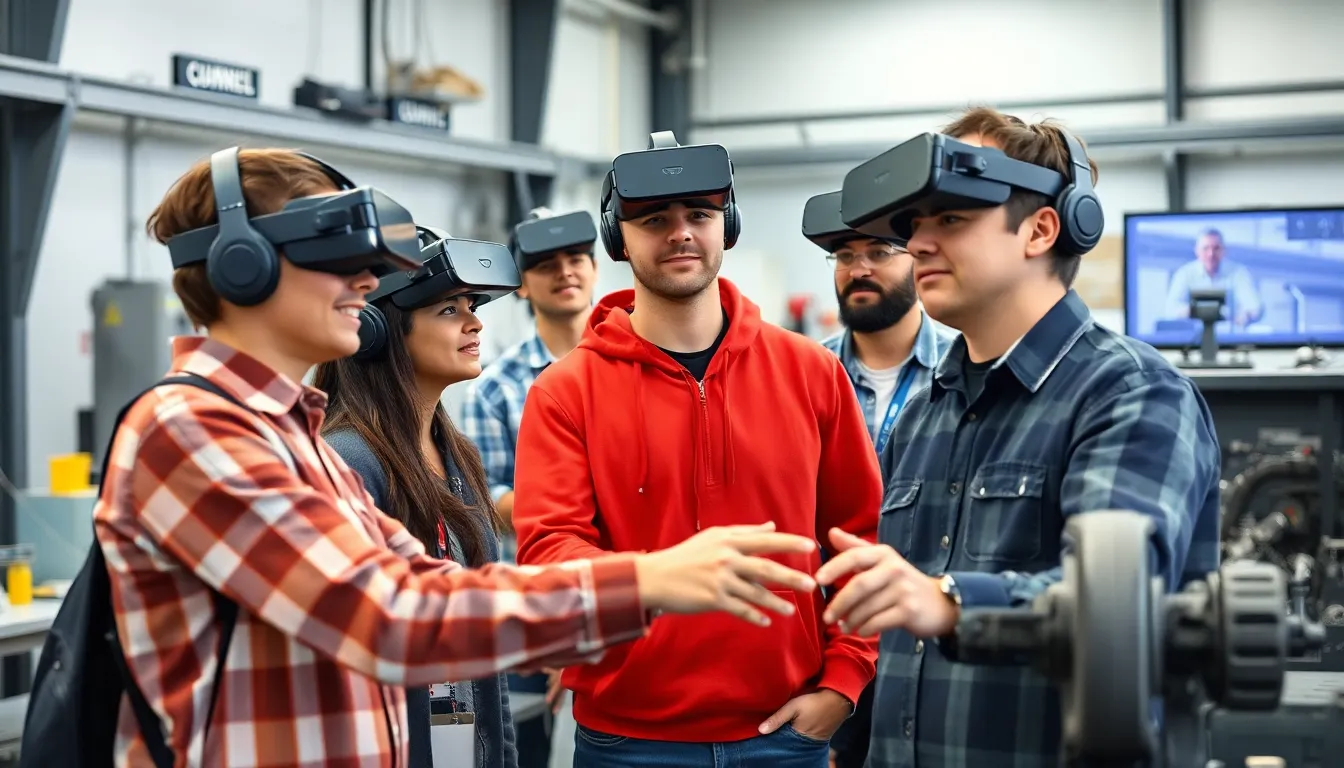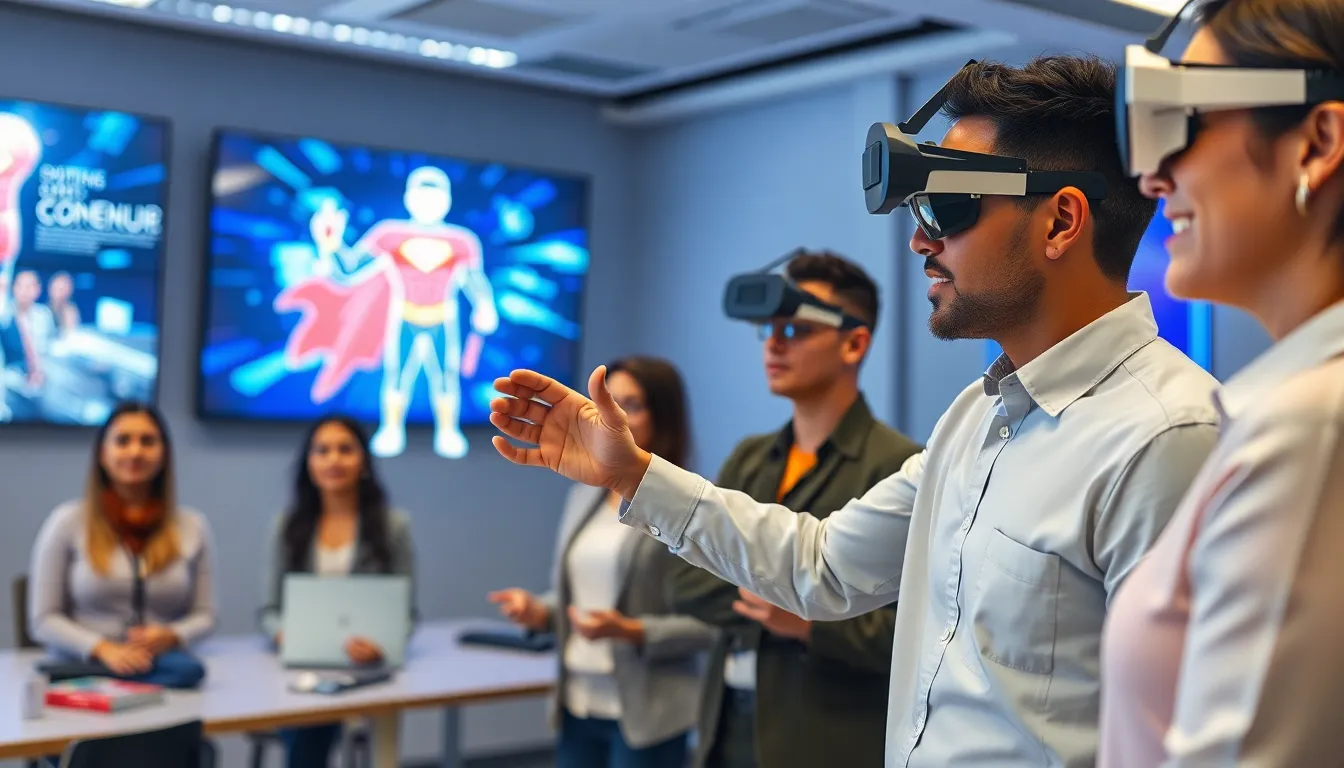Imagine stepping into a training session where your instructor isn’t just talking at you but is a holographic superhero guiding you through complex tasks. Welcome to the world of augmented reality training, where learning becomes an adventure rather than a chore. It’s like being in a video game, but instead of saving the world, you’re leveling up your skills.
Table of Contents
ToggleOverview of Augmented Reality Training
Augmented reality training represents a cutting-edge approach to education, integrating interactive elements into the learning process. This innovative method enhances user engagement and retention through immersive experiences.
Definition of Augmented Reality
Augmented reality (AR) overlays digital information onto the real world, blending physical and virtual environments. Users interact with computer-generated images or information, which enhances their perception of reality. This technology employs devices like smartphones, tablets, or AR glasses. By combining graphics, sounds, and sensations, AR creates a seamless, interactive experience for learners. In training scenarios, AR provides real-time feedback and guidance, making the learning process more intuitive and effective.
Importance in Training Environments
AR significantly impacts training environments by fostering hands-on learning opportunities. Engaging sessions improve knowledge retention and skill application. Many industries, including healthcare and manufacturing, have adopted AR for training purposes. The method reduces the time needed for training while increasing safety and proficiency. With simulated scenarios, employees can practice high-risk tasks without real-world consequences. Organizations see improved performance and employee confidence through AR-enhanced training programs.
Benefits of Augmented Reality Training

Augmented reality training offers significant advantages for businesses and learners. This innovative approach transforms traditional educational methods into an engaging and interactive experience.
Enhanced Learning Experience
Augmented reality creates immersive learning environments. Learners actively participate in real-time simulations that mimic practical scenarios. For example, a technician can practice repairing machinery without the risk of damaging actual equipment. The ability to visualize complex concepts helps learners grasp challenging material more effectively. Offering instant feedback during these simulations ensures users understand concepts before advancing. This hands-on approach fosters a deeper understanding of the subject matter.
Increased Engagement and Retention
Organizations experience higher engagement levels with augmented reality training. Interactive elements maintain learners’ interest, encouraging them to explore topics in greater depth. Statistics indicate that students engaged with AR technology retain information up to 70% longer than through traditional methods. This substantial improvement highlights the effectiveness of visual and interactive components in training. Additionally, learners become more motivated to complete training modules, resulting in enhanced productivity. Consequently, organizations notice a positive impact on overall training outcomes and employee performance.
Applications of Augmented Reality Training
Augmented reality training finds diverse applications across various sectors. Each industry utilizes this technology to enhance learning and skill development.
Corporate Training
Corporate training increasingly adopts augmented reality for its unique benefits. Companies use AR to simulate real-life scenarios, enabling employees to practice skills in a controlled setting. Training programs offering AR simulations can improve engagement among employees significantly. Employees retain information better, often remembering concepts up to 70% longer compared to traditional training methods. Managers observe increased productivity and efficiency, as employees develop skills more effectively. Moreover, AR training reduces the time spent in training sessions without compromising the quality of learning.
Healthcare Training
In healthcare, AR training proves revolutionary for teaching complex procedures. Medical professionals use AR to visualize anatomy and practice surgical techniques without real-world risks. Learners gain hands-on experience with no danger to patients. AR applications allow for real-time feedback during training, enhancing critical thinking skills. Statistics show that AR can decrease training time by up to 40%, helping healthcare professionals prepare more quickly for their roles. Patients benefit as well, receiving care from well-trained professionals equipped with the latest skills.
Educational Institutions
Educational institutions embrace augmented reality to create interactive learning environments. Teachers employ AR tools to engage students in immersive lessons that facilitate deeper understanding. Students can explore virtual models in subjects like science and history. Engagement levels rise as children learn more actively through interactive AR experiences. Research highlights that learners in AR-enhanced classrooms achieve better academic performance. Specifically, students show increased motivation and collaboration, enhancing the overall educational process. Institutions that implement AR training report impressive improvements in student retention rates.
Challenges in Implementing Augmented Reality Training
Augmented reality training presents unique challenges that organizations must navigate for effective integration. Understanding these challenges ensures successful adoption and deployment in various environments.
Technical Limitations
Technical limitations pose significant obstacles in augmented reality training. Hardware constraints such as device compatibility and processing power can hinder user experience. Many AR applications require high-quality graphics and robust systems, which may not be readily available in all workplaces. Network connectivity also plays a crucial role; inconsistent internet access can lead to interruptions during training sessions, reducing effectiveness. Developers must create applications that run efficiently across various platforms while maintaining performance standards.
Cost Considerations
Cost considerations impact the implementation of augmented reality training programs. Initial investment in AR technology often includes software development, hardware procurement, and ongoing maintenance. The expenses can be daunting for smaller organizations or those with tight budgets. Despite these costs, many large companies view AR training as a long-term investment that enhances employee skills and increases productivity, offsetting initial expenditures over time. Organizations can explore various funding options or partnerships to mitigate financial challenges associated with AR implementation.
User Adaptability
User adaptability is critical for the success of augmented reality training. Employees may struggle to adjust to new technologies, especially if they lack prior experience with AR. Effective training programs must incorporate user-friendly interfaces and intuitive navigation to facilitate learning. In some cases, resistance to adopting new systems can stem from fear of the unfamiliar. Organizations should prioritize user training and support to foster confidence, encouraging employees to embrace AR fully and maximize its potential benefits.
Future of Augmented Reality Training
Augmented reality (AR) training continues to evolve rapidly, reshaping how individuals learn and develop skills. The future promises even more advanced capabilities that enhance user experiences and drive efficiency.
Trends to Watch
Organizations increasingly adopt AR training for various applications, especially in healthcare and corporate sectors. Statistically, a projected 30% of companies plan to integrate AR into training programs by 2025. As AR technology becomes more accessible, mobile platforms are gaining traction, allowing employees to use familiar devices for training. Also, the industry shifts toward personalized learning experiences, enabling tailored content that adapts to individual needs and preferences. Biometric feedback mechanisms offer insights into learner engagement levels, enhancing real-time adjustments in AR training modules.
Potential Innovations
Innovations in AR training focus on enriching interactive experiences. Collaborative AR environments where multiple users can engage in training scenarios appear on the horizon. Artificial intelligence integration into AR systems enables adaptive learning pathways based on users’ strengths and weaknesses. Expect advancements in haptic feedback technology, providing realistic tactile sensations during training exercises. These developments aim to make training even more immersive, further bridging the gap between theory and practice. Additionally, gamification elements within AR training attract learners by incorporating competitive and rewarding features.
Augmented reality training is revolutionizing the way skills are developed across various industries. Its immersive nature not only enhances engagement but also significantly improves knowledge retention. By creating interactive learning environments, AR training allows users to practice in safe simulations that mimic real-world scenarios.
As organizations continue to embrace this technology, the potential for increased efficiency and employee confidence grows. The future of AR training looks promising with advancements in personalization and collaboration. By addressing current challenges and leveraging innovations, businesses can maximize the benefits of augmented reality, leading to a more skilled and adaptable workforce.





